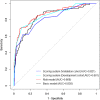Development and validation of a pre-scoring system for nonspecific low back pain among general population in Guangzhou: a cross-sectional study
- PMID: 31510992
- PMCID: PMC6739945
- DOI: 10.1186/s12889-019-7564-9
Development and validation of a pre-scoring system for nonspecific low back pain among general population in Guangzhou: a cross-sectional study
Abstract
Background: Nonspecific Low Back Pain (NLBP) is a common disease with a low cure rate and significant impact on the population. This study aimed to develop and validate a pre-scoring system for identifying the risk of suffering from NLBP among the general population in Guangzhou.
Methods: A total of 1439 eligible subjects were surveyed in Guangzhou by stratified random sampling and was divided randomly into the development dataset (69.6%) and validation dataset (30.4%) subsequently. Based on the development dataset, potential associated factors (average exercise times weekly, the intensity of daily work, etc.) with NLBP were tested by the sequential logistic regression, and a pre-scoring system was formulated with Sullivan's method and graded afterward. The internal validity of the system was assessed by AUC and calibration plot, and the external validation was performed in the validation dataset.
Results: The prevalence rates of NLBP in the development dataset and the validation dataset were 12.97 and 13.27%, respectively. Age, BMI, average exercise times weekly, gender, educational level, the intensity of daily work, place of residence, monthly income, overall evaluation of health condition and physiology health were identified as significant factors. The total risk score ranged from 0 to 38, which was split into three risk grades: low risk (0 to 18), intermediate risk (19 to 22) and high risk (23 to 38). The pre-scoring system had an adequate calibration and a good discriminating ability with bootstrap-corrected AUC equaling 0.861 in the development dataset and 0.821 in the validation dataset.
Conclusions: A pre-scoring system that could help clinicians to assess the risk of NLBP in the general population was validated. Further validation of the system in a new population or prospective cohort study is suggested.
Keywords: Associated factors; General population; Non-specific low back pain; Pre-scoring system.
Conflict of interest statement
The authors declare that they have no competing interests.
Figures



Similar articles
-
Risk factors analysis and risk prediction model construction of non-specific low back pain: an ambidirectional cohort study.J Orthop Surg Res. 2023 Jul 29;18(1):545. doi: 10.1186/s13018-023-03945-9. J Orthop Surg Res. 2023. PMID: 37516845 Free PMC article.
-
Evaluation of use and cost of medical care of common lumbar disorders in Korea: cross-sectional study of Korean Health Insurance Review and Assessment Service National Patient Sample data.BMJ Open. 2016 Sep 12;6(9):e012432. doi: 10.1136/bmjopen-2016-012432. BMJ Open. 2016. PMID: 27619830 Free PMC article.
-
Development, external validation, and comparative assessment of a new diagnostic score for hepatic steatosis.Am J Gastroenterol. 2014 Sep;109(9):1404-14. doi: 10.1038/ajg.2014.155. Epub 2014 Jun 24. Am J Gastroenterol. 2014. PMID: 24957156
-
Predicting pain recovery in patients with acute low back pain: Updating and validation of a clinical prediction model.Eur J Pain. 2019 Feb;23(2):341-353. doi: 10.1002/ejp.1308. Epub 2018 Sep 24. Eur J Pain. 2019. PMID: 30144211
-
A population-based study of juvenile disc degeneration and its association with overweight and obesity, low back pain, and diminished functional status.J Bone Joint Surg Am. 2011 Apr 6;93(7):662-70. doi: 10.2106/JBJS.I.01568. J Bone Joint Surg Am. 2011. PMID: 21471420
Cited by
-
Factors affecting functional disability in patients with non-specific chronic low back pain: a cross-sectional study.Front Neurol. 2024 May 1;15:1367400. doi: 10.3389/fneur.2024.1367400. eCollection 2024. Front Neurol. 2024. PMID: 38751880 Free PMC article.
References
-
- UK NCCF . Low back pain: early management of persistent non-specific low back pain. London: Royal College of General Practitioners (UK); 2009. - PubMed
MeSH terms
LinkOut - more resources
Full Text Sources

